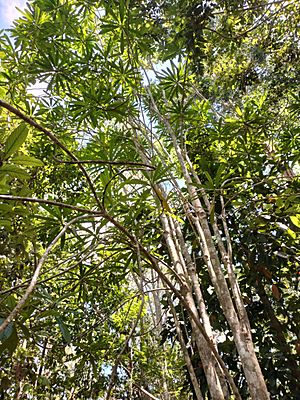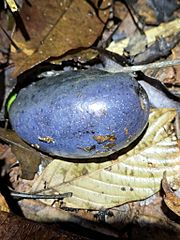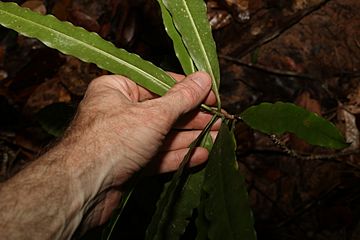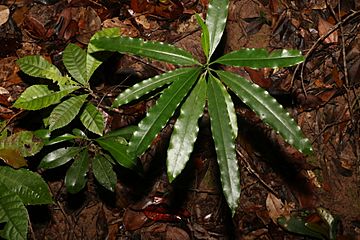Grey milkwood facts for kids
Quick facts for kids Cassowary plum |
|
|---|---|
 |
|
| Conservation status | |
|
Least Concern (NCA)
|
|
| Scientific classification | |
| Genus: |
Cerbera
|
| Species: |
inflata
|
| Synonyms | |
|
|
The Cassowary Plum (scientific name: Cerbera inflata) is a special plant. People also call it the grey milkwood, Joojooga, or rubber tree. It belongs to the Apocynaceae plant family. This tree grows only in one place: north-east Queensland, Australia. You can find it especially around the Atherton Tablelands.
Contents
About the Cassowary Plum Tree
The cassowary plum tree can grow very tall, up to 30 metres (about 98 feet) high. It has a grey trunk with cracks in its bark.
Its leaves are smooth and shiny. They are shaped like a spearhead, which is called lanceolate. The top of the leaves is a dull green, and the bottom is paler. Many leaves grow close together at the ends of the branches. Each leaf is about 10 to 26 cm (4 to 10 inches) long and 1.5 to 3 cm (0.6 to 1.2 inches) wide. They have many small veins, usually 33 to 37 on each side. If you cut any part of this tree, a lot of milky sap will come out.
Flowers and Fruit
The flowers of the cassowary plum grow in a cluster called a cyme. This cluster can be up to 15 cm (6 inches) long and usually has more than 50 flowers. Each flower has 5 white sepals, which are like small leaves that protect the bud.
The flowers also have a long tube, called a corolla tube, which is about 16 mm (0.6 inches) long. At the end of this tube are 5 white petals that spread out. The centre of the flower is cream or green. These sweet-smelling flowers are about 10 to 15 mm (0.4 to 0.6 inches) across.
The fruit of the cassowary plum is very colourful. It is a bright blue or purple drupe, which is a type of fruit with a hard pit inside, like a peach. The fruit is about 7 cm (2.8 inches) long and 3 cm (1.2 inches) wide. It has a slightly pointed end, and inside, there is one large seed.
How the Cassowary Plum Got Its Name
The cassowary plum was first described by a scientist named S. T. Blake in 1948. He first named it Cerbera dilatata. However, that name had already been used for another plant. So, in 1959, he gave it a new name: Cerbera inflata.
The second part of its scientific name, inflata, comes from a Latin word meaning "inflated" or "puffed up". This refers to the shape of the flower's tube.
Where the Cassowary Plum Lives
The Cerbera inflata tree grows only in Queensland, Australia. This means it is endemic to that area. It likes to grow in thick rainforests, both in the low foothills and higher up in the mountains. You can find it from the town of Innisfail all the way to the Atherton Tablelands. It grows at heights from 100 to 800 metres (about 330 to 2,600 feet) above sea level.
Life Cycle and Cassowaries
The cassowaries are very important for the cassowary plum. These large birds eat the fallen fruit whole. When they do, they help spread the seeds of the tree. This makes cassowaries the main way the cassowary plum seeds get carried to new places to grow.
Gallery






